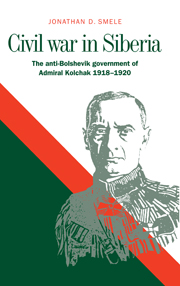Book contents
- Frontmatter
- Contents
- List of maps
- Preface
- Glossary and abbreviations
- Maps
- Introduction
- 1 The triumphal march of reaction
- 2 The establishment of the Kolchak Government
- 3 ‘What Kolchak Wants!’: military versus polity in White Siberia
- 4 Inside Kolchakia: from ‘a land of milk and honey’ to ‘the dictatorship of the whip’
- 5 White débâcle
- 6 White agony
- Conclusion
- Appendix The Anti-Bolshevik Governments in Siberia, 1918–1920
- Bibliography
- Index
1 - The triumphal march of reaction
Published online by Cambridge University Press: 03 November 2009
- Frontmatter
- Contents
- List of maps
- Preface
- Glossary and abbreviations
- Maps
- Introduction
- 1 The triumphal march of reaction
- 2 The establishment of the Kolchak Government
- 3 ‘What Kolchak Wants!’: military versus polity in White Siberia
- 4 Inside Kolchakia: from ‘a land of milk and honey’ to ‘the dictatorship of the whip’
- 5 White débâcle
- 6 White agony
- Conclusion
- Appendix The Anti-Bolshevik Governments in Siberia, 1918–1920
- Bibliography
- Index
Summary
The counter-revolution in Siberia, which has hitherto developed under the banner of the petite-bourgeoisie, must now evolve into military dictatorship–counter-revolution in its most severe form.
Such was the verdict of the first underground conference of Siberian Bolsheviks at Tomsk on August 23rd 1918. This clandestine party meeting was held almost three months after what Lenin termed the ‘Triumphal March of Soviet Power’ had been rudely reversed east of the Volga by the famous revolt of the Czechoslovak Legion–those armed ex-POWs, en route for evacuation via Vladivostok in order to join the Allied cause in France, who had despaired under their maltreatment at the hands of the Soviet authorities and had then seized control of the Trans-Siberian Railway and its environs. Three months later, with the establishment of an avowedly militaristic government at Omsk in November 1918, the fugitive Bolsheviks’ prediction would be fulfilled, as the triumphal march of reaction reached its zenith in a White Siberia.
Between times, in September 1918, representatives of the myriad anti-Bolshevik governments which established themselves, under the aegis of the Czechoslovaks, to claim authority over territories from the Volga to the Pacific, would yet gather to parley at a grand State Conference, at Ufa. And there, indeed, contending parties would merge uneasily in the guise of a Provisional All-Russian Government, the Directory, which was committed to democracy. This, however, proved to be an unworkable and toothless compromise of a Coalition, respected by neither of the chief pretenders to power in the east during the summer of 1918 – the Socialist-Revolutionary (SR) dominated Committe of Members of the Constituent Assembly (Komuch), at Samara; and the more right-wing Provisional Siberian Government (PSG), based at Omsk.
- Type
- Chapter
- Information
- Civil War in SiberiaThe Anti-Bolshevik Government of Admiral Kolchak, 1918–1920, pp. 10 - 107Publisher: Cambridge University PressPrint publication year: 1997



